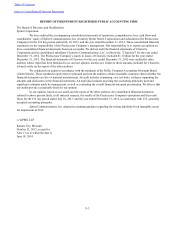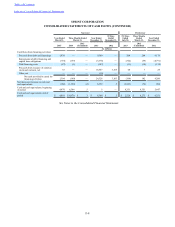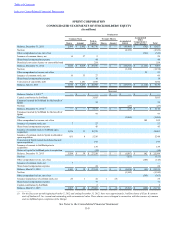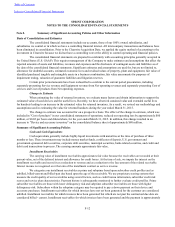Sprint - Nextel 2014 Annual Report Download - page 95
Download and view the complete annual report
Please find page 95 of the 2014 Sprint - Nextel annual report below. You can navigate through the pages in the report by either clicking on the pages listed below, or by using the keyword search tool below to find specific information within the annual report.
Table of Contents
Index to Consolidated Financial Statements
SPRINT CORPORATION
NOTES TO THE CONSOLIDATED FINANCIAL STATEMENTS
F-12
Note 2. Summary of Significant Accounting Policies and Other Information
Basis of Consolidation and Estimates
The consolidated financial statements include our accounts, those of our 100% owned subsidiaries, and
subsidiaries we control or in which we have a controlling financial interest. All intercompany transactions and balances have
been eliminated in consolidation. Prior to the Clearwire Acquisition Date, we applied the equity method of accounting to the
investment in Clearwire because we did not have a controlling vote or the ability to control operating and financial policies.
The consolidated financial statements are prepared in conformity with accounting principles generally accepted in
the United States (U.S. GAAP). This requires management of the Company to make estimates and assumptions that affect the
reported amounts of assets and liabilities, revenues and expenses and the disclosure of contingent assets and liabilities as of
the date of the consolidated financial statements. Significant estimates and assumptions are used for, but are not limited to,
allowance for doubtful accounts, estimated economic lives and residual values of property, plant and equipment, fair value of
identified purchased tangible and intangible assets in a business combination, fair value assessments for purposes of
impairment testing, valuation of guarantee liabilities and litigation reserves.
Certain prior period amounts have been reclassified to conform to the current period presentation, including
separately presenting Service revenue and Equipment revenue from Net operating revenues and separately presenting Cost of
services and Cost of products from Net operating expenses.
Change in Estimate
When estimating the value of returned inventory, we evaluate many factors and obtain information to support the
estimated value of used devices and the useful lives. Recently, we have observed sustained value and extended useful lives
for handsets leading to an increase in the estimated value for returned inventory. As a result, we revised our methodology and
assumptions used in estimating the value for returned handsets during the year ended March 31, 2015.
The change in estimate was accounted for on a prospective basis. The effect of the change in estimate, which was
included in "Cost of products" in our consolidated statements of operations, reduced our operating loss by approximately $80
million, or $0.02 per basic and diluted share, for the year ended March 31, 2015. In addition, this change resulted in an
increase to "Device and accessory inventory" on the consolidated balance sheet of approximately $80 million.
Summary of Significant Accounting Policies
Cash and Cash Equivalents
Cash equivalents generally include highly liquid investments with maturities at the time of purchase of three
months or less. These investments may include money market funds, certificates of deposit, U.S. government and
government-sponsored debt securities, corporate debt securities, municipal securities, bank-related securities, and credit and
debit card transactions in process. The carrying amounts approximate fair value.
Installment Receivables
The carrying value of installment receivables approximates fair value because the receivables are recorded at their
present value, net of the deferred interest and allowance for credit losses. At the time of sale, we impute the interest on the
installment receivable and record it as a reduction to revenue and as a reduction to the face amount of the related receivable.
Interest income is recognized over the term of the installment contract as service revenue.
We categorize our installment receivables as prime and subprime based upon subscriber credit profiles and as
unbilled, billed-current and billed-past due based upon the age of the receivable. We use proprietary scoring systems that
measure the credit quality of our receivables using several factors, such as credit bureau information, subscriber credit risk
scores and service plan characteristics. Payment history is subsequently monitored to further evaluate credit profiles. Prime
subscriber receivables are those with lower delinquency risk and subprime subscriber receivables are those with higher
delinquency risk. Subscribers within the subprime category may be required to pay a down payment on their device and
accessory purchases. Installment receivables for which invoices have not yet been generated for the customer are considered
unbilled. Installment receivables for which invoices have been generated but which are not past the contractual due date are
considered billed - current. Installment receivables for which invoices have been generated and the payment is approximately
























